Culture and IHRM: Analysis of HR Practices in Different Countries
VerifiedAdded on 2023/01/06
|11
|3945
|1
Report
AI Summary
This report delves into the intricacies of International Human Resource Management (IHRM), specifically focusing on how cultural differences impact key HR practices. The report examines three crucial HR functions: recruitment and selection, training and development, and rewarding and compensation, and illustrates how these are implemented differently across various countries. The analysis includes comparing the recruitment processes of Tata (India) and Deloitte (UK), highlighting similarities and differences, and uses the Hofstede model to explain cultural influences. Furthermore, the report contrasts training and development approaches at Nestle (Switzerland) and IBM (US), examining the types of training provided and how they align with the respective company cultures. Finally, the report explores reward management strategies at Tesco (UK) and Honda (Japan), considering how these companies motivate and compensate employees within their specific cultural contexts. The report emphasizes the importance of understanding cultural nuances in order to effectively manage HR activities on a global scale.

Culture and IHRM
Paraphrase This Document
Need a fresh take? Get an instant paraphrase of this document with our AI Paraphraser

Table of Contents
INTRODUCTION ..........................................................................................................................2
Main Body ......................................................................................................................................3
Recruitment and selection - Tata (India) and Delloite (UK) ..........................................................3
Function..................................................................................................................................3
Training and development - Nestle (Switzerland) and IBM (US).................................................5
Function..................................................................................................................................5
Rewarding and compensation - Tesco (UK) and Honda (Japan)....................................................6
CONCLUSION ...............................................................................................................................8
REFERENCES................................................................................................................................9
INTRODUCTION ..........................................................................................................................2
Main Body ......................................................................................................................................3
Recruitment and selection - Tata (India) and Delloite (UK) ..........................................................3
Function..................................................................................................................................3
Training and development - Nestle (Switzerland) and IBM (US).................................................5
Function..................................................................................................................................5
Rewarding and compensation - Tesco (UK) and Honda (Japan)....................................................6
CONCLUSION ...............................................................................................................................8
REFERENCES................................................................................................................................9

INTRODUCTION
International human resource management is defined as the term used for companies
which are operating in international markets. There is need to manage the HR activities at
international level for enhancing effective functioning of the company. IHRM helps in managing
expatriate management, multiple industrial relation activities in order to meet legal and tax
requirements. It is important to understand different culture and allow them for cooperating with
employees from different areas (Aust, Muller-Camen, and Poutsma, 2018). This enables
working of different employees in different countries. Strong connections are required for
implementing effective human resource management. This report consists of three HR functions
– Recruitment and selection, Training and development and rewarding and compensation. These
are differently operated in different countries. The following report describes difference between
implementation of these functions in context of two different countries. Recruitment and
selection is known as the process by which employees are hired within any company. This is
important for different organisational culture to follow a common process to recruit employees.
Selecting employees is a way used for managing the type of employees hired. Training and
development is the process that is used for enhancing skills of employees and staff members.
Also, another HR practise reward management is effectively promoted within organisations for
proper functioning.
Main Body
Recruitment and selection
Function
The process of recruitment is defined as process by which employees are offered
selection in the company. This is a method in which prospective employees are searched and
motivated for applying jobs within different organisations. This is a process of employment and
it includes a long process consisting of different tasks and activities (Sanders, and De Cieri,
2020). There are different tasks involved in process of recruitment such as job requirements,
vacancy advertisement, attracting customer for applying jobs, short listing candidates, etc. There
are different recruitment strategies adopted by HR practitioners including internal and external.
In context of internal recruitment, company hires candidates through promotion, retrenched
International human resource management is defined as the term used for companies
which are operating in international markets. There is need to manage the HR activities at
international level for enhancing effective functioning of the company. IHRM helps in managing
expatriate management, multiple industrial relation activities in order to meet legal and tax
requirements. It is important to understand different culture and allow them for cooperating with
employees from different areas (Aust, Muller-Camen, and Poutsma, 2018). This enables
working of different employees in different countries. Strong connections are required for
implementing effective human resource management. This report consists of three HR functions
– Recruitment and selection, Training and development and rewarding and compensation. These
are differently operated in different countries. The following report describes difference between
implementation of these functions in context of two different countries. Recruitment and
selection is known as the process by which employees are hired within any company. This is
important for different organisational culture to follow a common process to recruit employees.
Selecting employees is a way used for managing the type of employees hired. Training and
development is the process that is used for enhancing skills of employees and staff members.
Also, another HR practise reward management is effectively promoted within organisations for
proper functioning.
Main Body
Recruitment and selection
Function
The process of recruitment is defined as process by which employees are offered
selection in the company. This is a method in which prospective employees are searched and
motivated for applying jobs within different organisations. This is a process of employment and
it includes a long process consisting of different tasks and activities (Sanders, and De Cieri,
2020). There are different tasks involved in process of recruitment such as job requirements,
vacancy advertisement, attracting customer for applying jobs, short listing candidates, etc. There
are different recruitment strategies adopted by HR practitioners including internal and external.
In context of internal recruitment, company hires candidates through promotion, retrenched
⊘ This is a preview!⊘
Do you want full access?
Subscribe today to unlock all pages.

Trusted by 1+ million students worldwide
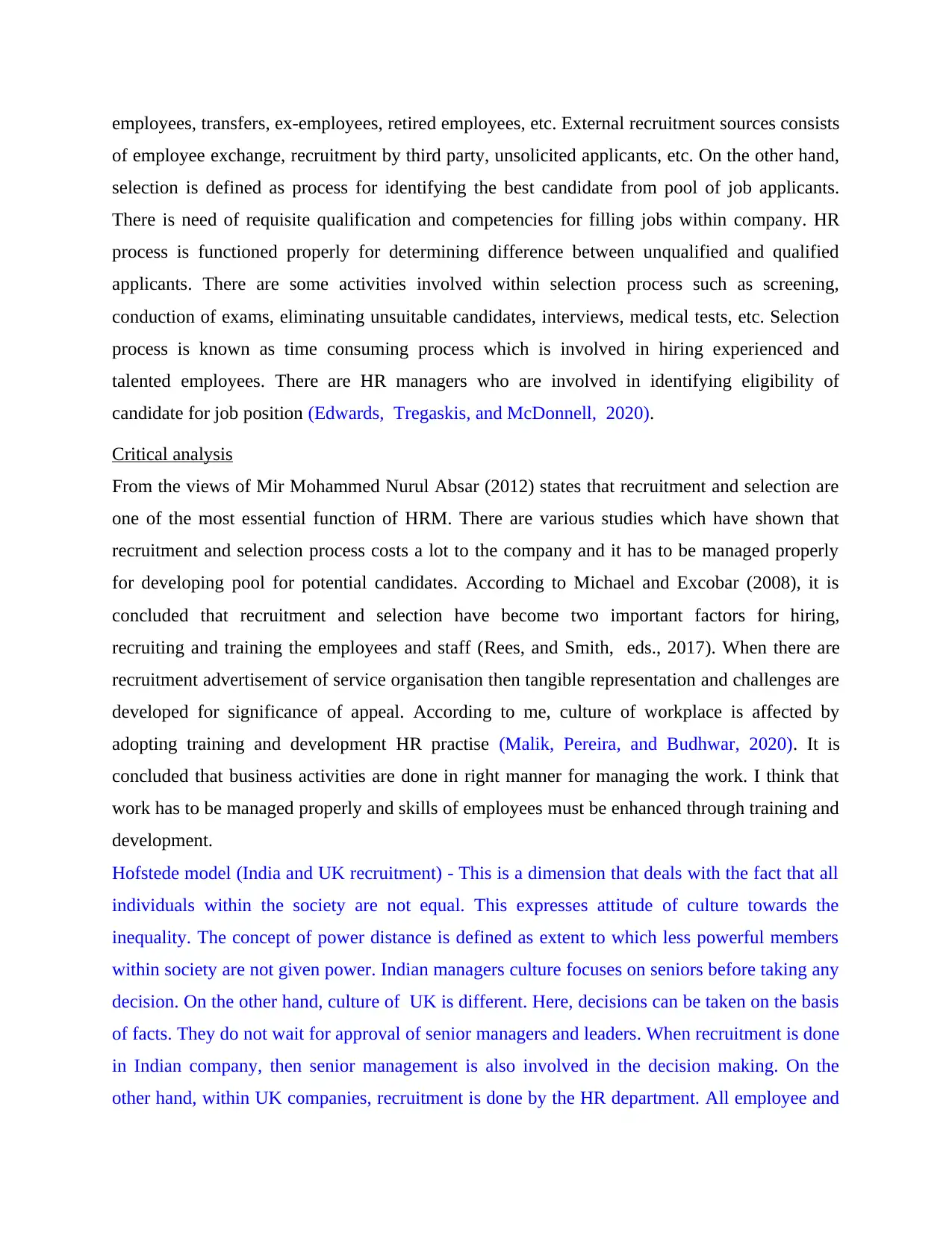
employees, transfers, ex-employees, retired employees, etc. External recruitment sources consists
of employee exchange, recruitment by third party, unsolicited applicants, etc. On the other hand,
selection is defined as process for identifying the best candidate from pool of job applicants.
There is need of requisite qualification and competencies for filling jobs within company. HR
process is functioned properly for determining difference between unqualified and qualified
applicants. There are some activities involved within selection process such as screening,
conduction of exams, eliminating unsuitable candidates, interviews, medical tests, etc. Selection
process is known as time consuming process which is involved in hiring experienced and
talented employees. There are HR managers who are involved in identifying eligibility of
candidate for job position (Edwards, Tregaskis, and McDonnell, 2020).
Critical analysis
From the views of Mir Mohammed Nurul Absar (2012) states that recruitment and selection are
one of the most essential function of HRM. There are various studies which have shown that
recruitment and selection process costs a lot to the company and it has to be managed properly
for developing pool for potential candidates. According to Michael and Excobar (2008), it is
concluded that recruitment and selection have become two important factors for hiring,
recruiting and training the employees and staff (Rees, and Smith, eds., 2017). When there are
recruitment advertisement of service organisation then tangible representation and challenges are
developed for significance of appeal. According to me, culture of workplace is affected by
adopting training and development HR practise (Malik, Pereira, and Budhwar, 2020). It is
concluded that business activities are done in right manner for managing the work. I think that
work has to be managed properly and skills of employees must be enhanced through training and
development.
Hofstede model (India and UK recruitment) - This is a dimension that deals with the fact that all
individuals within the society are not equal. This expresses attitude of culture towards the
inequality. The concept of power distance is defined as extent to which less powerful members
within society are not given power. Indian managers culture focuses on seniors before taking any
decision. On the other hand, culture of UK is different. Here, decisions can be taken on the basis
of facts. They do not wait for approval of senior managers and leaders. When recruitment is done
in Indian company, then senior management is also involved in the decision making. On the
other hand, within UK companies, recruitment is done by the HR department. All employee and
of employee exchange, recruitment by third party, unsolicited applicants, etc. On the other hand,
selection is defined as process for identifying the best candidate from pool of job applicants.
There is need of requisite qualification and competencies for filling jobs within company. HR
process is functioned properly for determining difference between unqualified and qualified
applicants. There are some activities involved within selection process such as screening,
conduction of exams, eliminating unsuitable candidates, interviews, medical tests, etc. Selection
process is known as time consuming process which is involved in hiring experienced and
talented employees. There are HR managers who are involved in identifying eligibility of
candidate for job position (Edwards, Tregaskis, and McDonnell, 2020).
Critical analysis
From the views of Mir Mohammed Nurul Absar (2012) states that recruitment and selection are
one of the most essential function of HRM. There are various studies which have shown that
recruitment and selection process costs a lot to the company and it has to be managed properly
for developing pool for potential candidates. According to Michael and Excobar (2008), it is
concluded that recruitment and selection have become two important factors for hiring,
recruiting and training the employees and staff (Rees, and Smith, eds., 2017). When there are
recruitment advertisement of service organisation then tangible representation and challenges are
developed for significance of appeal. According to me, culture of workplace is affected by
adopting training and development HR practise (Malik, Pereira, and Budhwar, 2020). It is
concluded that business activities are done in right manner for managing the work. I think that
work has to be managed properly and skills of employees must be enhanced through training and
development.
Hofstede model (India and UK recruitment) - This is a dimension that deals with the fact that all
individuals within the society are not equal. This expresses attitude of culture towards the
inequality. The concept of power distance is defined as extent to which less powerful members
within society are not given power. Indian managers culture focuses on seniors before taking any
decision. On the other hand, culture of UK is different. Here, decisions can be taken on the basis
of facts. They do not wait for approval of senior managers and leaders. When recruitment is done
in Indian company, then senior management is also involved in the decision making. On the
other hand, within UK companies, recruitment is done by the HR department. All employee and
Paraphrase This Document
Need a fresh take? Get an instant paraphrase of this document with our AI Paraphraser
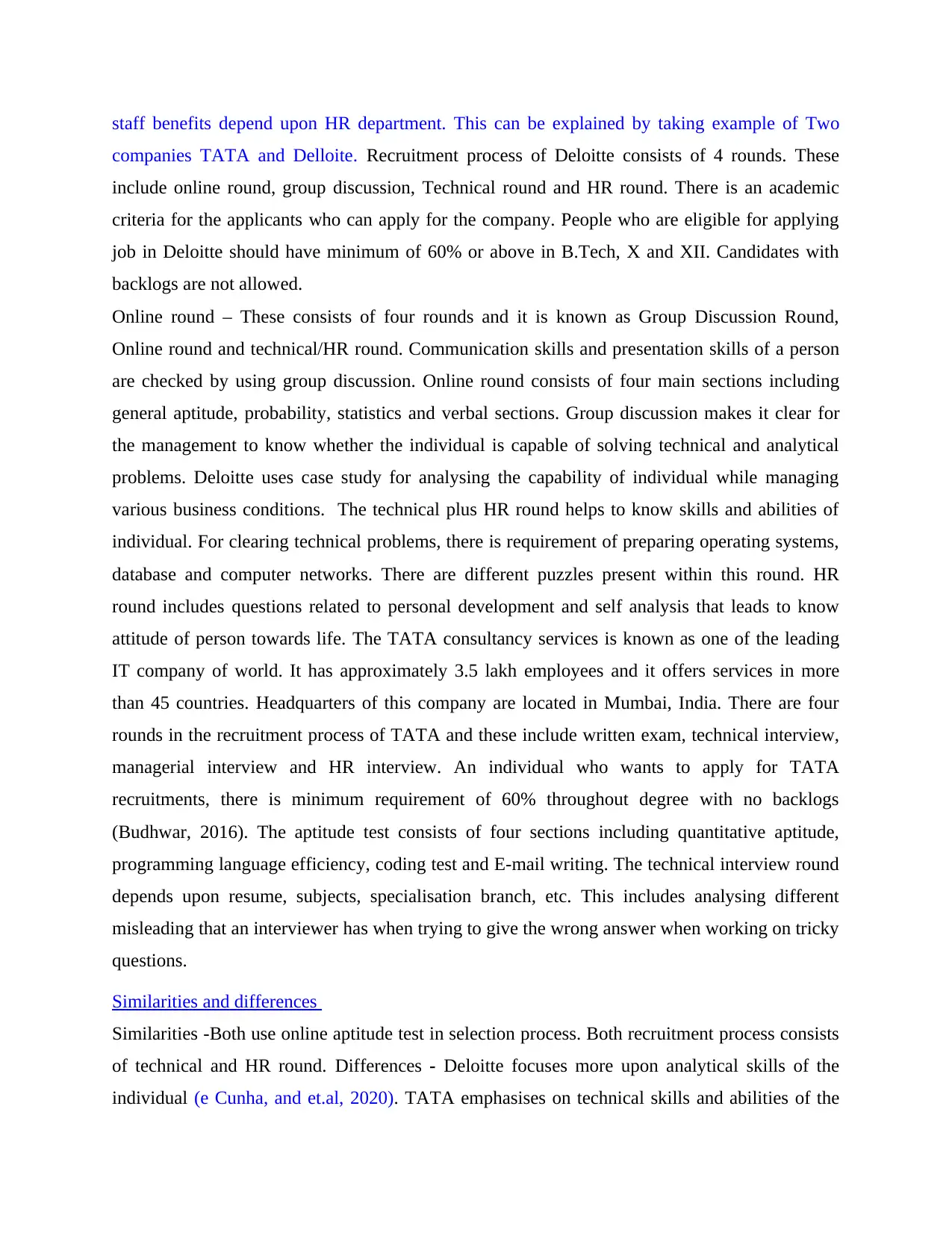
staff benefits depend upon HR department. This can be explained by taking example of Two
companies TATA and Delloite. Recruitment process of Deloitte consists of 4 rounds. These
include online round, group discussion, Technical round and HR round. There is an academic
criteria for the applicants who can apply for the company. People who are eligible for applying
job in Deloitte should have minimum of 60% or above in B.Tech, X and XII. Candidates with
backlogs are not allowed.
Online round – These consists of four rounds and it is known as Group Discussion Round,
Online round and technical/HR round. Communication skills and presentation skills of a person
are checked by using group discussion. Online round consists of four main sections including
general aptitude, probability, statistics and verbal sections. Group discussion makes it clear for
the management to know whether the individual is capable of solving technical and analytical
problems. Deloitte uses case study for analysing the capability of individual while managing
various business conditions. The technical plus HR round helps to know skills and abilities of
individual. For clearing technical problems, there is requirement of preparing operating systems,
database and computer networks. There are different puzzles present within this round. HR
round includes questions related to personal development and self analysis that leads to know
attitude of person towards life. The TATA consultancy services is known as one of the leading
IT company of world. It has approximately 3.5 lakh employees and it offers services in more
than 45 countries. Headquarters of this company are located in Mumbai, India. There are four
rounds in the recruitment process of TATA and these include written exam, technical interview,
managerial interview and HR interview. An individual who wants to apply for TATA
recruitments, there is minimum requirement of 60% throughout degree with no backlogs
(Budhwar, 2016). The aptitude test consists of four sections including quantitative aptitude,
programming language efficiency, coding test and E-mail writing. The technical interview round
depends upon resume, subjects, specialisation branch, etc. This includes analysing different
misleading that an interviewer has when trying to give the wrong answer when working on tricky
questions.
Similarities and differences
Similarities -Both use online aptitude test in selection process. Both recruitment process consists
of technical and HR round. Differences - Deloitte focuses more upon analytical skills of the
individual (e Cunha, and et.al, 2020). TATA emphasises on technical skills and abilities of the
companies TATA and Delloite. Recruitment process of Deloitte consists of 4 rounds. These
include online round, group discussion, Technical round and HR round. There is an academic
criteria for the applicants who can apply for the company. People who are eligible for applying
job in Deloitte should have minimum of 60% or above in B.Tech, X and XII. Candidates with
backlogs are not allowed.
Online round – These consists of four rounds and it is known as Group Discussion Round,
Online round and technical/HR round. Communication skills and presentation skills of a person
are checked by using group discussion. Online round consists of four main sections including
general aptitude, probability, statistics and verbal sections. Group discussion makes it clear for
the management to know whether the individual is capable of solving technical and analytical
problems. Deloitte uses case study for analysing the capability of individual while managing
various business conditions. The technical plus HR round helps to know skills and abilities of
individual. For clearing technical problems, there is requirement of preparing operating systems,
database and computer networks. There are different puzzles present within this round. HR
round includes questions related to personal development and self analysis that leads to know
attitude of person towards life. The TATA consultancy services is known as one of the leading
IT company of world. It has approximately 3.5 lakh employees and it offers services in more
than 45 countries. Headquarters of this company are located in Mumbai, India. There are four
rounds in the recruitment process of TATA and these include written exam, technical interview,
managerial interview and HR interview. An individual who wants to apply for TATA
recruitments, there is minimum requirement of 60% throughout degree with no backlogs
(Budhwar, 2016). The aptitude test consists of four sections including quantitative aptitude,
programming language efficiency, coding test and E-mail writing. The technical interview round
depends upon resume, subjects, specialisation branch, etc. This includes analysing different
misleading that an interviewer has when trying to give the wrong answer when working on tricky
questions.
Similarities and differences
Similarities -Both use online aptitude test in selection process. Both recruitment process consists
of technical and HR round. Differences - Deloitte focuses more upon analytical skills of the
individual (e Cunha, and et.al, 2020). TATA emphasises on technical skills and abilities of the
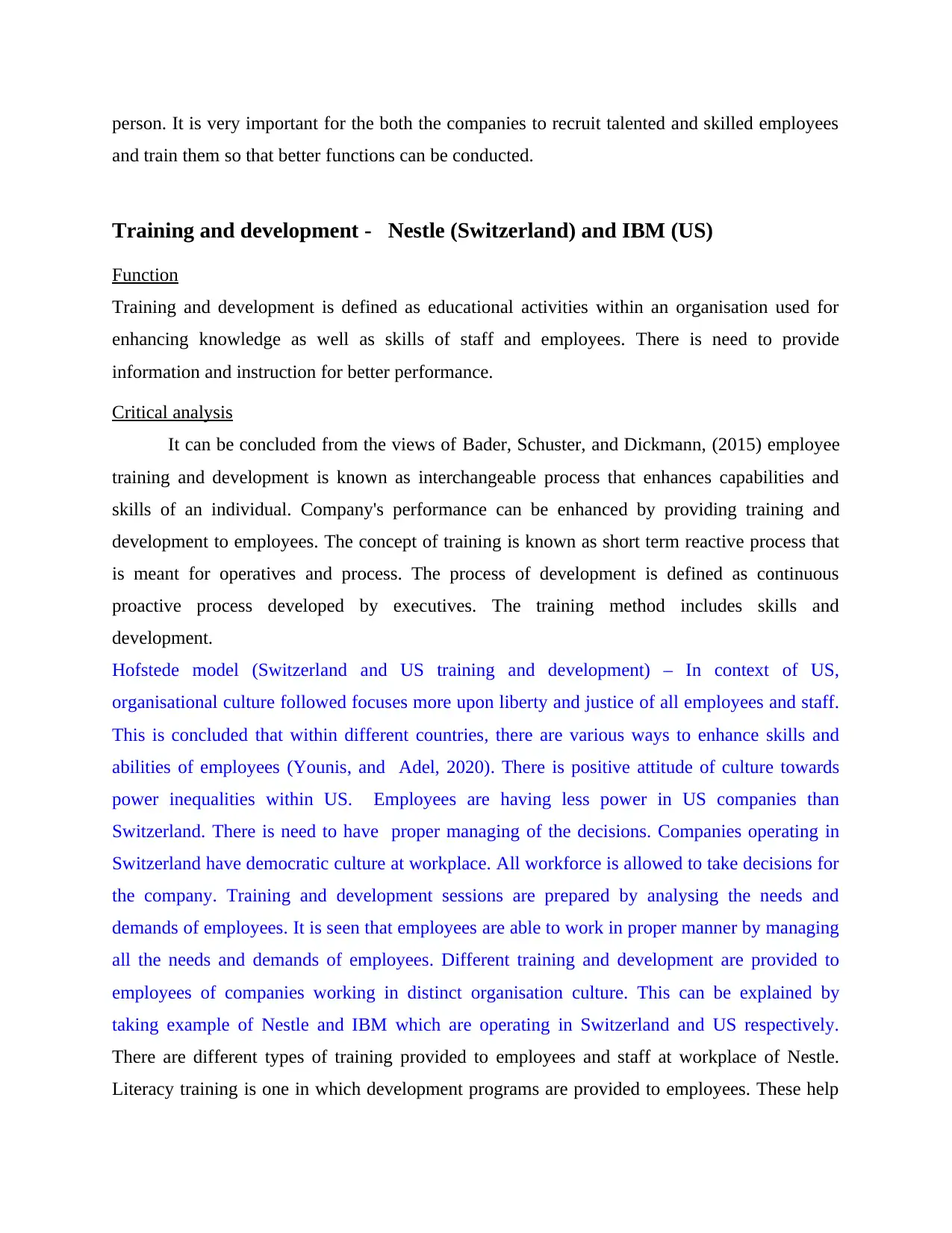
person. It is very important for the both the companies to recruit talented and skilled employees
and train them so that better functions can be conducted.
Training and development - Nestle (Switzerland) and IBM (US)
Function
Training and development is defined as educational activities within an organisation used for
enhancing knowledge as well as skills of staff and employees. There is need to provide
information and instruction for better performance.
Critical analysis
It can be concluded from the views of Bader, Schuster, and Dickmann, (2015) employee
training and development is known as interchangeable process that enhances capabilities and
skills of an individual. Company's performance can be enhanced by providing training and
development to employees. The concept of training is known as short term reactive process that
is meant for operatives and process. The process of development is defined as continuous
proactive process developed by executives. The training method includes skills and
development.
Hofstede model (Switzerland and US training and development) – In context of US,
organisational culture followed focuses more upon liberty and justice of all employees and staff.
This is concluded that within different countries, there are various ways to enhance skills and
abilities of employees (Younis, and Adel, 2020). There is positive attitude of culture towards
power inequalities within US. Employees are having less power in US companies than
Switzerland. There is need to have proper managing of the decisions. Companies operating in
Switzerland have democratic culture at workplace. All workforce is allowed to take decisions for
the company. Training and development sessions are prepared by analysing the needs and
demands of employees. It is seen that employees are able to work in proper manner by managing
all the needs and demands of employees. Different training and development are provided to
employees of companies working in distinct organisation culture. This can be explained by
taking example of Nestle and IBM which are operating in Switzerland and US respectively.
There are different types of training provided to employees and staff at workplace of Nestle.
Literacy training is one in which development programs are provided to employees. These help
and train them so that better functions can be conducted.
Training and development - Nestle (Switzerland) and IBM (US)
Function
Training and development is defined as educational activities within an organisation used for
enhancing knowledge as well as skills of staff and employees. There is need to provide
information and instruction for better performance.
Critical analysis
It can be concluded from the views of Bader, Schuster, and Dickmann, (2015) employee
training and development is known as interchangeable process that enhances capabilities and
skills of an individual. Company's performance can be enhanced by providing training and
development to employees. The concept of training is known as short term reactive process that
is meant for operatives and process. The process of development is defined as continuous
proactive process developed by executives. The training method includes skills and
development.
Hofstede model (Switzerland and US training and development) – In context of US,
organisational culture followed focuses more upon liberty and justice of all employees and staff.
This is concluded that within different countries, there are various ways to enhance skills and
abilities of employees (Younis, and Adel, 2020). There is positive attitude of culture towards
power inequalities within US. Employees are having less power in US companies than
Switzerland. There is need to have proper managing of the decisions. Companies operating in
Switzerland have democratic culture at workplace. All workforce is allowed to take decisions for
the company. Training and development sessions are prepared by analysing the needs and
demands of employees. It is seen that employees are able to work in proper manner by managing
all the needs and demands of employees. Different training and development are provided to
employees of companies working in distinct organisation culture. This can be explained by
taking example of Nestle and IBM which are operating in Switzerland and US respectively.
There are different types of training provided to employees and staff at workplace of Nestle.
Literacy training is one in which development programs are provided to employees. These help
⊘ This is a preview!⊘
Do you want full access?
Subscribe today to unlock all pages.

Trusted by 1+ million students worldwide

in upgrading essential literacy skills of the person. These are important programs as flexibility
and independence among team workers are operating efficiently. Apprenticeship program
promotes young trainees to spent three weeks at work and two at school. This training program
provides help in enhancing microbiology, finance, bakery, etc. The main motive of IBM is to
enhance the skills of employees and get chance to success. IBM skills are helpful for students,
job seekers and professionals to build critical skills by using online courses, badge credentials
and programs. There are majorly technical program and training provided to employees at IBM.
There is need for evaluating different skills so that work and activities of business are conducted
properly.
Similarities and differences
Similarities - Both training methods are emphasising upon building skills and abilities of
employees. It will help to increase overall performance of employees as well as companies. The
training methods are developed according to the convenience of employees. Differences - Nestle
and IBM are companies which are operating in different countries. For Nestle operating in
Switzerland, employees are provided different kind of training. On the other hand, for IBM,
employees are provided training that will help in enhancing technical skills of employees. IBM
works in software development and thus, there is main focus upon increasing computing and IT
skills of the person. Nestle employees are provided training that are mainly about marketing and
finance skills, analytical ability and interpersonal skills. Training and development affects
organisational culture in direct manner. This is seen that when there is positive workplace culture
then training and development plays an important role. There is need for managing training as
well as development sessions for conducting the business activities properly.
Rewarding and compensation - Tesco (UK) and Honda (Japan)
Reward management is defined as the crucial strategy used within HRM. There are two
types of rewards including tangible and intangible (Dickmann, Brewster, and Sparrow, eds.,
2016). These are provided to the employees for motivating and encouraging them to attain
organisational targets and goals. For employees, reward is known as return in exchange of the
performance and this is appreciated by employer. Different organisations provide reward to
employees for boosting their confidence and managing different business activities. Companies
have to care about performance of employees. Major objective of companies is to enhance profit
and independence among team workers are operating efficiently. Apprenticeship program
promotes young trainees to spent three weeks at work and two at school. This training program
provides help in enhancing microbiology, finance, bakery, etc. The main motive of IBM is to
enhance the skills of employees and get chance to success. IBM skills are helpful for students,
job seekers and professionals to build critical skills by using online courses, badge credentials
and programs. There are majorly technical program and training provided to employees at IBM.
There is need for evaluating different skills so that work and activities of business are conducted
properly.
Similarities and differences
Similarities - Both training methods are emphasising upon building skills and abilities of
employees. It will help to increase overall performance of employees as well as companies. The
training methods are developed according to the convenience of employees. Differences - Nestle
and IBM are companies which are operating in different countries. For Nestle operating in
Switzerland, employees are provided different kind of training. On the other hand, for IBM,
employees are provided training that will help in enhancing technical skills of employees. IBM
works in software development and thus, there is main focus upon increasing computing and IT
skills of the person. Nestle employees are provided training that are mainly about marketing and
finance skills, analytical ability and interpersonal skills. Training and development affects
organisational culture in direct manner. This is seen that when there is positive workplace culture
then training and development plays an important role. There is need for managing training as
well as development sessions for conducting the business activities properly.
Rewarding and compensation - Tesco (UK) and Honda (Japan)
Reward management is defined as the crucial strategy used within HRM. There are two
types of rewards including tangible and intangible (Dickmann, Brewster, and Sparrow, eds.,
2016). These are provided to the employees for motivating and encouraging them to attain
organisational targets and goals. For employees, reward is known as return in exchange of the
performance and this is appreciated by employer. Different organisations provide reward to
employees for boosting their confidence and managing different business activities. Companies
have to care about performance of employees. Major objective of companies is to enhance profit
Paraphrase This Document
Need a fresh take? Get an instant paraphrase of this document with our AI Paraphraser
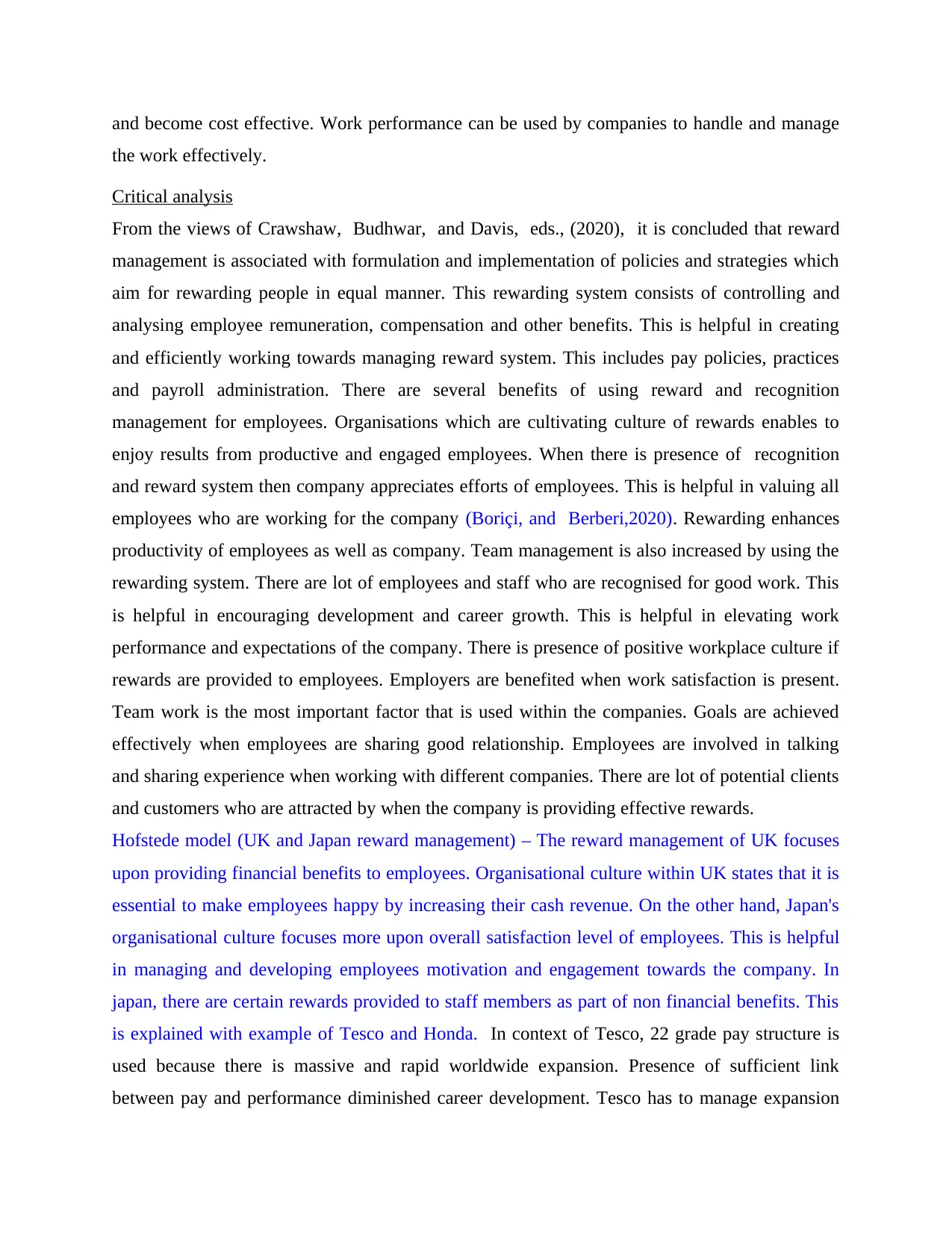
and become cost effective. Work performance can be used by companies to handle and manage
the work effectively.
Critical analysis
From the views of Crawshaw, Budhwar, and Davis, eds., (2020), it is concluded that reward
management is associated with formulation and implementation of policies and strategies which
aim for rewarding people in equal manner. This rewarding system consists of controlling and
analysing employee remuneration, compensation and other benefits. This is helpful in creating
and efficiently working towards managing reward system. This includes pay policies, practices
and payroll administration. There are several benefits of using reward and recognition
management for employees. Organisations which are cultivating culture of rewards enables to
enjoy results from productive and engaged employees. When there is presence of recognition
and reward system then company appreciates efforts of employees. This is helpful in valuing all
employees who are working for the company (Boriçi, and Berberi,2020). Rewarding enhances
productivity of employees as well as company. Team management is also increased by using the
rewarding system. There are lot of employees and staff who are recognised for good work. This
is helpful in encouraging development and career growth. This is helpful in elevating work
performance and expectations of the company. There is presence of positive workplace culture if
rewards are provided to employees. Employers are benefited when work satisfaction is present.
Team work is the most important factor that is used within the companies. Goals are achieved
effectively when employees are sharing good relationship. Employees are involved in talking
and sharing experience when working with different companies. There are lot of potential clients
and customers who are attracted by when the company is providing effective rewards.
Hofstede model (UK and Japan reward management) – The reward management of UK focuses
upon providing financial benefits to employees. Organisational culture within UK states that it is
essential to make employees happy by increasing their cash revenue. On the other hand, Japan's
organisational culture focuses more upon overall satisfaction level of employees. This is helpful
in managing and developing employees motivation and engagement towards the company. In
japan, there are certain rewards provided to staff members as part of non financial benefits. This
is explained with example of Tesco and Honda. In context of Tesco, 22 grade pay structure is
used because there is massive and rapid worldwide expansion. Presence of sufficient link
between pay and performance diminished career development. Tesco has to manage expansion
the work effectively.
Critical analysis
From the views of Crawshaw, Budhwar, and Davis, eds., (2020), it is concluded that reward
management is associated with formulation and implementation of policies and strategies which
aim for rewarding people in equal manner. This rewarding system consists of controlling and
analysing employee remuneration, compensation and other benefits. This is helpful in creating
and efficiently working towards managing reward system. This includes pay policies, practices
and payroll administration. There are several benefits of using reward and recognition
management for employees. Organisations which are cultivating culture of rewards enables to
enjoy results from productive and engaged employees. When there is presence of recognition
and reward system then company appreciates efforts of employees. This is helpful in valuing all
employees who are working for the company (Boriçi, and Berberi,2020). Rewarding enhances
productivity of employees as well as company. Team management is also increased by using the
rewarding system. There are lot of employees and staff who are recognised for good work. This
is helpful in encouraging development and career growth. This is helpful in elevating work
performance and expectations of the company. There is presence of positive workplace culture if
rewards are provided to employees. Employers are benefited when work satisfaction is present.
Team work is the most important factor that is used within the companies. Goals are achieved
effectively when employees are sharing good relationship. Employees are involved in talking
and sharing experience when working with different companies. There are lot of potential clients
and customers who are attracted by when the company is providing effective rewards.
Hofstede model (UK and Japan reward management) – The reward management of UK focuses
upon providing financial benefits to employees. Organisational culture within UK states that it is
essential to make employees happy by increasing their cash revenue. On the other hand, Japan's
organisational culture focuses more upon overall satisfaction level of employees. This is helpful
in managing and developing employees motivation and engagement towards the company. In
japan, there are certain rewards provided to staff members as part of non financial benefits. This
is explained with example of Tesco and Honda. In context of Tesco, 22 grade pay structure is
used because there is massive and rapid worldwide expansion. Presence of sufficient link
between pay and performance diminished career development. Tesco has to manage expansion

in market and for this, new broad banded structure and this allows managers to manage
employees pay. There are new line managers in this company who provide rewards to employees
and produce own potential staff for company's success. Honda is a company that believes
human beings are free individuals and they are creative enough to plan their dream world
Mahadevan, and Kilian-Yasin, (2017), This company provides rewards to employees in the form
of financial source that helps in enhancing and motivating an individual's career growth (Macini,
and et.al, 2020). Honda provides respect to all it's employees and there are three elements of
initiatives including initiative, trust and equality. These are included in fundamental belief of
Honda and this company conduct business activities properly. Direct deposit is known as
arrangement with local financial institutions which are used for direct deposits of the pay for
checking savings accounts. Direct deposit is present through Honda federal credit union. Bonus
sharing is a program that is used by Honda to thank employees for their contribution and
becoming part of the company. Employees are part of the this reward system if they are having
base earnings with bonus sharing period. When an individual is employed by Honda on last day
of Bonus sharing period and he is an employee that is providing temporary associates for
employment of Honda (Zardasht, Omed, and Taha, 2020). Award program - This is known as
program initiated by Honda for allowing individual associates to submit ideas for improving
various business aspects of Honda. This is involved in planning, implementing and
documentation of different Honda aspects. NH Circle Program – This is an activity within Honda
that is used for solving problems and implementing improvements associated with work.
Similarities and differences
The Similarity between Honda and Tesco is that Both training are developed according
to the skills of employees.Both training programs require involvement of employees and
increases employee engagement. The difference between reward management of Tesco and
Honda is discussed. In context of Honda, benefit program is helpful for managing direct payroll
deposits according to the convenience. Rewards are provided for contribution to success of
Honda through bonus sharing. Recognition and award guidelines are present within Honda
which are used from the administration department. On the other hand, Tesco operating in UK
does not has good reward management system. Employees are not happy by the reward
management of this company.
employees pay. There are new line managers in this company who provide rewards to employees
and produce own potential staff for company's success. Honda is a company that believes
human beings are free individuals and they are creative enough to plan their dream world
Mahadevan, and Kilian-Yasin, (2017), This company provides rewards to employees in the form
of financial source that helps in enhancing and motivating an individual's career growth (Macini,
and et.al, 2020). Honda provides respect to all it's employees and there are three elements of
initiatives including initiative, trust and equality. These are included in fundamental belief of
Honda and this company conduct business activities properly. Direct deposit is known as
arrangement with local financial institutions which are used for direct deposits of the pay for
checking savings accounts. Direct deposit is present through Honda federal credit union. Bonus
sharing is a program that is used by Honda to thank employees for their contribution and
becoming part of the company. Employees are part of the this reward system if they are having
base earnings with bonus sharing period. When an individual is employed by Honda on last day
of Bonus sharing period and he is an employee that is providing temporary associates for
employment of Honda (Zardasht, Omed, and Taha, 2020). Award program - This is known as
program initiated by Honda for allowing individual associates to submit ideas for improving
various business aspects of Honda. This is involved in planning, implementing and
documentation of different Honda aspects. NH Circle Program – This is an activity within Honda
that is used for solving problems and implementing improvements associated with work.
Similarities and differences
The Similarity between Honda and Tesco is that Both training are developed according
to the skills of employees.Both training programs require involvement of employees and
increases employee engagement. The difference between reward management of Tesco and
Honda is discussed. In context of Honda, benefit program is helpful for managing direct payroll
deposits according to the convenience. Rewards are provided for contribution to success of
Honda through bonus sharing. Recognition and award guidelines are present within Honda
which are used from the administration department. On the other hand, Tesco operating in UK
does not has good reward management system. Employees are not happy by the reward
management of this company.
⊘ This is a preview!⊘
Do you want full access?
Subscribe today to unlock all pages.

Trusted by 1+ million students worldwide
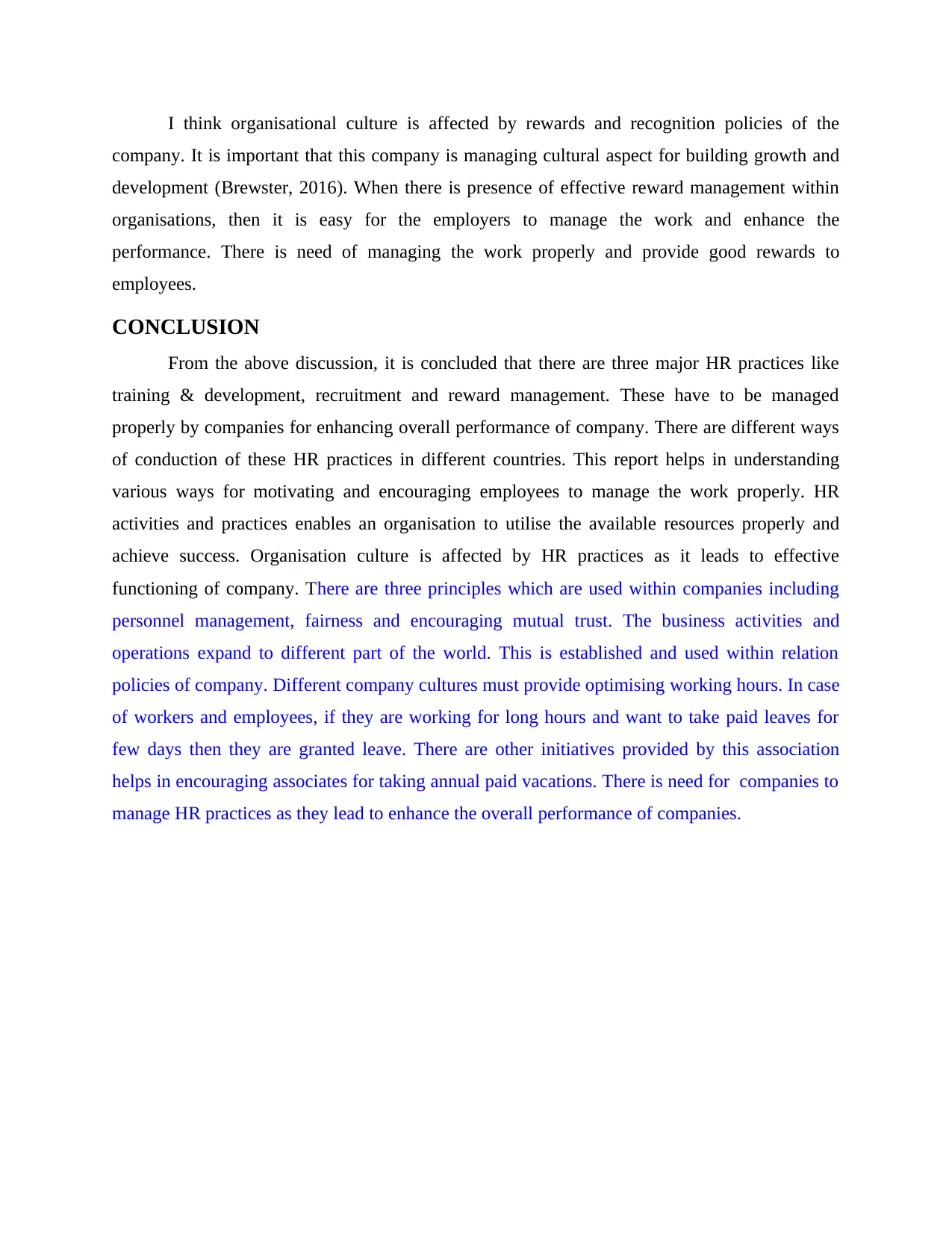
I think organisational culture is affected by rewards and recognition policies of the
company. It is important that this company is managing cultural aspect for building growth and
development (Brewster, 2016). When there is presence of effective reward management within
organisations, then it is easy for the employers to manage the work and enhance the
performance. There is need of managing the work properly and provide good rewards to
employees.
CONCLUSION
From the above discussion, it is concluded that there are three major HR practices like
training & development, recruitment and reward management. These have to be managed
properly by companies for enhancing overall performance of company. There are different ways
of conduction of these HR practices in different countries. This report helps in understanding
various ways for motivating and encouraging employees to manage the work properly. HR
activities and practices enables an organisation to utilise the available resources properly and
achieve success. Organisation culture is affected by HR practices as it leads to effective
functioning of company. There are three principles which are used within companies including
personnel management, fairness and encouraging mutual trust. The business activities and
operations expand to different part of the world. This is established and used within relation
policies of company. Different company cultures must provide optimising working hours. In case
of workers and employees, if they are working for long hours and want to take paid leaves for
few days then they are granted leave. There are other initiatives provided by this association
helps in encouraging associates for taking annual paid vacations. There is need for companies to
manage HR practices as they lead to enhance the overall performance of companies.
company. It is important that this company is managing cultural aspect for building growth and
development (Brewster, 2016). When there is presence of effective reward management within
organisations, then it is easy for the employers to manage the work and enhance the
performance. There is need of managing the work properly and provide good rewards to
employees.
CONCLUSION
From the above discussion, it is concluded that there are three major HR practices like
training & development, recruitment and reward management. These have to be managed
properly by companies for enhancing overall performance of company. There are different ways
of conduction of these HR practices in different countries. This report helps in understanding
various ways for motivating and encouraging employees to manage the work properly. HR
activities and practices enables an organisation to utilise the available resources properly and
achieve success. Organisation culture is affected by HR practices as it leads to effective
functioning of company. There are three principles which are used within companies including
personnel management, fairness and encouraging mutual trust. The business activities and
operations expand to different part of the world. This is established and used within relation
policies of company. Different company cultures must provide optimising working hours. In case
of workers and employees, if they are working for long hours and want to take paid leaves for
few days then they are granted leave. There are other initiatives provided by this association
helps in encouraging associates for taking annual paid vacations. There is need for companies to
manage HR practices as they lead to enhance the overall performance of companies.
Paraphrase This Document
Need a fresh take? Get an instant paraphrase of this document with our AI Paraphraser
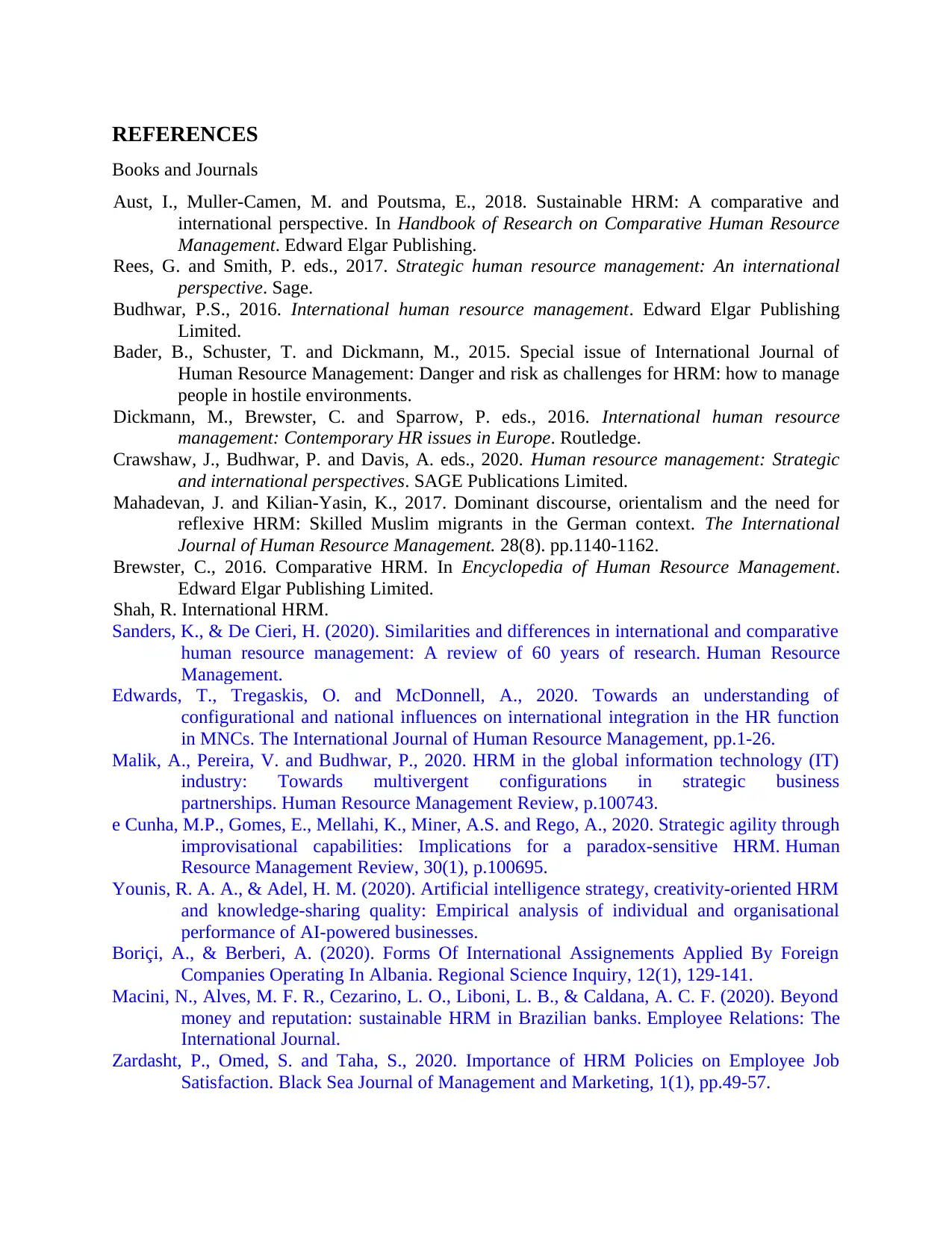
REFERENCES
Books and Journals
Aust, I., Muller-Camen, M. and Poutsma, E., 2018. Sustainable HRM: A comparative and
international perspective. In Handbook of Research on Comparative Human Resource
Management. Edward Elgar Publishing.
Rees, G. and Smith, P. eds., 2017. Strategic human resource management: An international
perspective. Sage.
Budhwar, P.S., 2016. International human resource management. Edward Elgar Publishing
Limited.
Bader, B., Schuster, T. and Dickmann, M., 2015. Special issue of International Journal of
Human Resource Management: Danger and risk as challenges for HRM: how to manage
people in hostile environments.
Dickmann, M., Brewster, C. and Sparrow, P. eds., 2016. International human resource
management: Contemporary HR issues in Europe. Routledge.
Crawshaw, J., Budhwar, P. and Davis, A. eds., 2020. Human resource management: Strategic
and international perspectives. SAGE Publications Limited.
Mahadevan, J. and Kilian-Yasin, K., 2017. Dominant discourse, orientalism and the need for
reflexive HRM: Skilled Muslim migrants in the German context. The International
Journal of Human Resource Management. 28(8). pp.1140-1162.
Brewster, C., 2016. Comparative HRM. In Encyclopedia of Human Resource Management.
Edward Elgar Publishing Limited.
Shah, R. International HRM.
Sanders, K., & De Cieri, H. (2020). Similarities and differences in international and comparative
human resource management: A review of 60 years of research. Human Resource
Management.
Edwards, T., Tregaskis, O. and McDonnell, A., 2020. Towards an understanding of
configurational and national influences on international integration in the HR function
in MNCs. The International Journal of Human Resource Management, pp.1-26.
Malik, A., Pereira, V. and Budhwar, P., 2020. HRM in the global information technology (IT)
industry: Towards multivergent configurations in strategic business
partnerships. Human Resource Management Review, p.100743.
e Cunha, M.P., Gomes, E., Mellahi, K., Miner, A.S. and Rego, A., 2020. Strategic agility through
improvisational capabilities: Implications for a paradox-sensitive HRM. Human
Resource Management Review, 30(1), p.100695.
Younis, R. A. A., & Adel, H. M. (2020). Artificial intelligence strategy, creativity-oriented HRM
and knowledge-sharing quality: Empirical analysis of individual and organisational
performance of AI-powered businesses.
Boriçi, A., & Berberi, A. (2020). Forms Of International Assignements Applied By Foreign
Companies Operating In Albania. Regional Science Inquiry, 12(1), 129-141.
Macini, N., Alves, M. F. R., Cezarino, L. O., Liboni, L. B., & Caldana, A. C. F. (2020). Beyond
money and reputation: sustainable HRM in Brazilian banks. Employee Relations: The
International Journal.
Zardasht, P., Omed, S. and Taha, S., 2020. Importance of HRM Policies on Employee Job
Satisfaction. Black Sea Journal of Management and Marketing, 1(1), pp.49-57.
Books and Journals
Aust, I., Muller-Camen, M. and Poutsma, E., 2018. Sustainable HRM: A comparative and
international perspective. In Handbook of Research on Comparative Human Resource
Management. Edward Elgar Publishing.
Rees, G. and Smith, P. eds., 2017. Strategic human resource management: An international
perspective. Sage.
Budhwar, P.S., 2016. International human resource management. Edward Elgar Publishing
Limited.
Bader, B., Schuster, T. and Dickmann, M., 2015. Special issue of International Journal of
Human Resource Management: Danger and risk as challenges for HRM: how to manage
people in hostile environments.
Dickmann, M., Brewster, C. and Sparrow, P. eds., 2016. International human resource
management: Contemporary HR issues in Europe. Routledge.
Crawshaw, J., Budhwar, P. and Davis, A. eds., 2020. Human resource management: Strategic
and international perspectives. SAGE Publications Limited.
Mahadevan, J. and Kilian-Yasin, K., 2017. Dominant discourse, orientalism and the need for
reflexive HRM: Skilled Muslim migrants in the German context. The International
Journal of Human Resource Management. 28(8). pp.1140-1162.
Brewster, C., 2016. Comparative HRM. In Encyclopedia of Human Resource Management.
Edward Elgar Publishing Limited.
Shah, R. International HRM.
Sanders, K., & De Cieri, H. (2020). Similarities and differences in international and comparative
human resource management: A review of 60 years of research. Human Resource
Management.
Edwards, T., Tregaskis, O. and McDonnell, A., 2020. Towards an understanding of
configurational and national influences on international integration in the HR function
in MNCs. The International Journal of Human Resource Management, pp.1-26.
Malik, A., Pereira, V. and Budhwar, P., 2020. HRM in the global information technology (IT)
industry: Towards multivergent configurations in strategic business
partnerships. Human Resource Management Review, p.100743.
e Cunha, M.P., Gomes, E., Mellahi, K., Miner, A.S. and Rego, A., 2020. Strategic agility through
improvisational capabilities: Implications for a paradox-sensitive HRM. Human
Resource Management Review, 30(1), p.100695.
Younis, R. A. A., & Adel, H. M. (2020). Artificial intelligence strategy, creativity-oriented HRM
and knowledge-sharing quality: Empirical analysis of individual and organisational
performance of AI-powered businesses.
Boriçi, A., & Berberi, A. (2020). Forms Of International Assignements Applied By Foreign
Companies Operating In Albania. Regional Science Inquiry, 12(1), 129-141.
Macini, N., Alves, M. F. R., Cezarino, L. O., Liboni, L. B., & Caldana, A. C. F. (2020). Beyond
money and reputation: sustainable HRM in Brazilian banks. Employee Relations: The
International Journal.
Zardasht, P., Omed, S. and Taha, S., 2020. Importance of HRM Policies on Employee Job
Satisfaction. Black Sea Journal of Management and Marketing, 1(1), pp.49-57.
1 out of 11
Related Documents
Your All-in-One AI-Powered Toolkit for Academic Success.
+13062052269
info@desklib.com
Available 24*7 on WhatsApp / Email
![[object Object]](/_next/static/media/star-bottom.7253800d.svg)
Unlock your academic potential
Copyright © 2020–2025 A2Z Services. All Rights Reserved. Developed and managed by ZUCOL.




